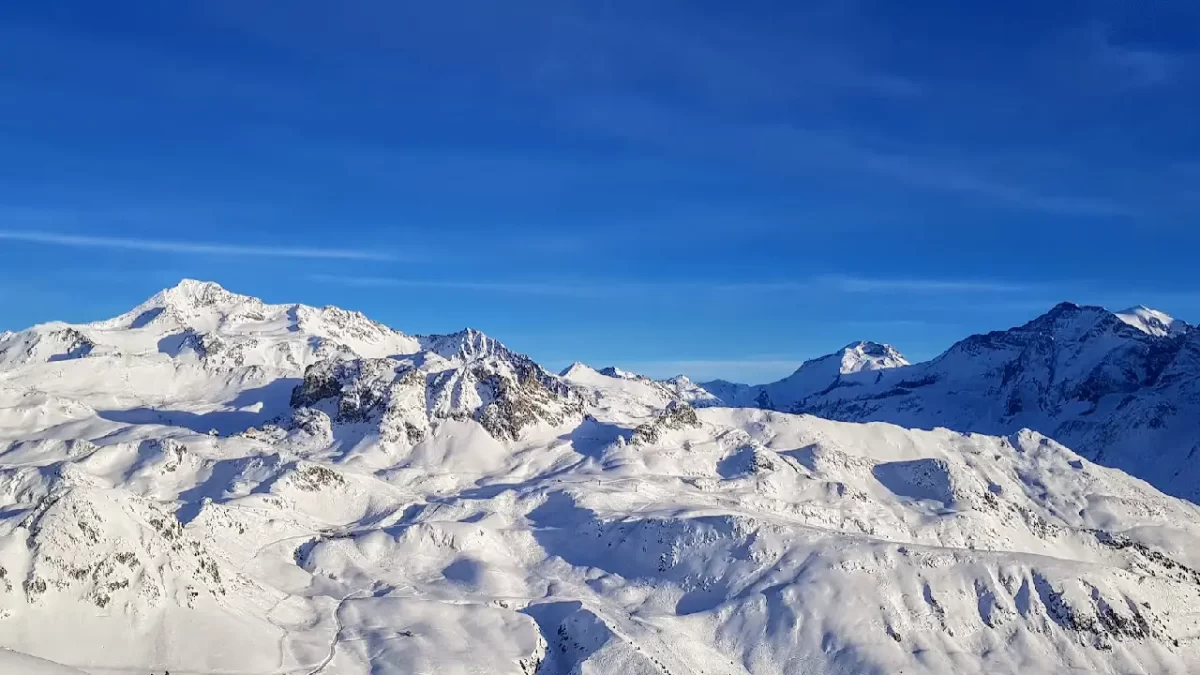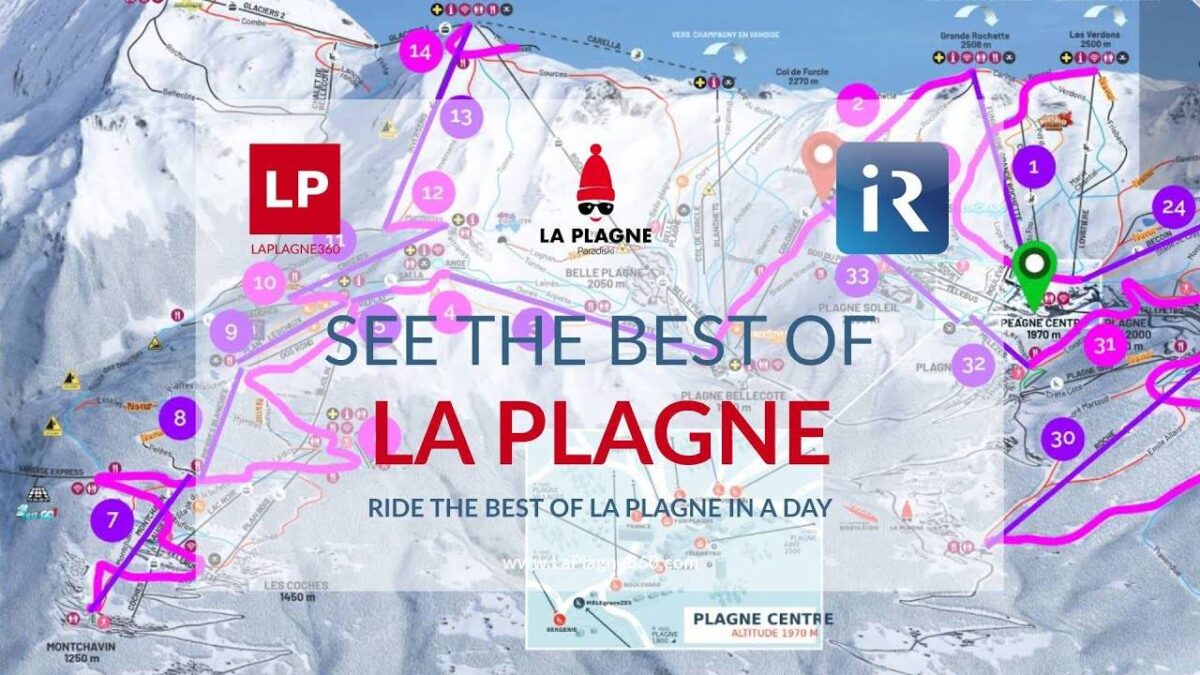Is La Plagne good for experts?

As an advanced skier or snowboarder, you likely already have an idea of the main resorts and how they stack up against each other. You’ve also likely holidayed in many of these resorts but may not know the answer to the question, ‘Is La Plagne good for advanced riders?‘ If this sounds like you, read on for more information.
Note – La Plagne 360 guides are human-written, not generated by ChatGPT or similar AI software.
The spectrum of advanced riders
Advanced skiers and snowboarders should be able to turn fluidly and in control on all but the most tricky black pistes or backcountry routes. Advanced skiers concentrate more on honing their technique and body mechanics rather than having to think about turn initiation or carving. One key difference between an intermediate and advanced skier is that intermediates tend to rely upon their upper body to turn whereas advanced riders use a combination of gravity and turn technique – in particular, high ski angulation and hip, knee and ankle flex. The difference between an advanced skier and an expert is often questionable but, as a general guide, most people agree experts can handle all types of snow, gradients or conditions (eg moguls, powder, ice) with ease whereas advanced skiers may have difficulty in these more varied environments.
The same applies to advanced snowboarders – their focus will be far more on strengthening their turn technique and body positioning. As above, an advanced snowboarder should be able to comfortably make their way down the majority of runs in a resort. They should have also developed the different types of snowboard turn (eg down-unweighting, up-unweighting, jump turns, etc) as well as shifting their body mass along the length of the board to dictate different types and shapes of turn. The idea of being able to handle different types of snow and conditions also applies.
Red and black vs advanced and expert
As with most other European ski areas, La Plagne separates its runs into four classifications – green (beginner), blue (intermediate), red (advanced) and black (expert). However, for the purposes of this feature, we’re going to group advanced and expert levels together. After all, let’s face it – if you’re a true expert skier or snowboarder, you’ll know it and will already have a clear idea of the types of runs you can handle. Also, only a very few riders can truly consider themselves to be experts.
Should advanced riders get the full Paradiski pass?
Without doubt advanced / expert riders get the most from the full area Paradiski pass. In general, the pistes on the Les Arcs side tend to be a little more testing — and there are considerably more black and red piste challenges on this part of the area (plus a lot of off-piste on offer). Moreover, the Paradiski pass virtually doubles the available terrain while the route from La Plagne to Les Arcs is quick and easy. Note – the journey back takes longer with multiple lifts so you should factor this into your return trip to La Plagne. Also, if you’re in a group of mixed abilities, you might want to check our Is La Plagne good for beginners and Is La Plagne good for intermediates pages.
Advice for advanced riders in La Plagne
La Plagne is the world’s most popular ski resort – and for good reason. If you look at the majority of skiers and snowboarders, they typically fall somewhere on the spectrum of intermediate riders – and La Plagne just happens to have intermediate terrain in abundance. There’s little doubt these two factors combined help explain La Plagne’s enduring popularity. This doesn’t mean that advanced skiers and snowboarders won’t enjoy riding the resort’s easier pistes – just don’t be expecting much in the way of on-piste challenging runs.
In truth, the vast majority of the runs in La Plagne are best suited to intermediate-level skiers and snowboarders. Sure, there are some trickier reds and blacks but these really are few and far between – and, in the case of the black runs, they tend to be pretty short. Rather, the biggest challenges in La Plagne for advanced riders lie in its challenging off-piste routes. Other off-piste opportunities are also listed below. Note – in all cases, if you’re heading out-of-bounds, you should take adequate precautions and, for safety, hire a guide. Barely a season goes by in La Plagne without avalanche / off-piste accidents and deaths.
Best advanced rider areas in La Plagne
Plagne Centre best advanced areas: Plagne Centre has two black runs – the Rochette off Grande Rochette and the Frisbee off Les Verdons. However, while it’s true the top sections are pretty steep, the gradient soon mellows into a considerably flatter pitch. For bigger challenges, there are off-piste routes down the chutes off Grande Rochette (you need a guide). As for the reds, the Carina and Banzai runs off the same two summits are rightly graded as advanced but, again, they’re both very short.
Plagne Villages best advanced areas: There are no advanced runs around Plagne Villages – although the top of the Mira piste is quite steep for a blue.
Plagne Soleil best advanced areas: As above, there are no advanced runs around Plagne Soleil.
Plagne Bellecôte / Belle Plagne best advanced areas: There are three red options in the Bellecôte bowl – The Sources, Inversens and Lognan pistes (the Lognan rarely seems to open for some reason). As an option, you could extend the Sources onto the Belle Plagne blue down to Bellecôte – a fun and fast route even if not especially challenging. As for black runs, you’ll find none here however there are multiple off-piste routes down the bowl above Belle Plagne under the Roche de Mio gondola (you need a guide in this avalanche-prone area).
Plagne 1800 best advanced areas: Plagne 1800 has one black run – the Crêtes Côte – which is one of the better blacks in the resort, especially after fresh snow. Other than that, most of the runs here are short link pistes to get back to the village, for example the Les Mines and Lovatière red (previously graded blue).
Plagne Aime 2000 best advanced areas: The Aime 2000 sector has the highest concentration of La Plagne black pistes – but, even then, most follow a very similar path into the bowl at the back of Aime and have very similar gradients down the hill. As for the pistes on the front, the Crêtes Côte mentioned above is good while the Java red, Grande Pente black and Gavotte red are all only steep in the top sections and soon mellow to much flatter gradients. There are, however, extensive off-piste opportunities in this area – especially if you hike from the top of the Crêtes drag lift (you need a guide). As for the reds, the Emile Allais and André Martzolf are two of the longer La Plagne advanced runs, even if they aren’t particularly steep.
Plagne Montalbert best advanced areas: Plagne Montalbert has no black runs but the reds here are good and much longer than in most other areas of La Plagne. Also, all the runs in the sector can be accessed from the Montalbert gondola which is usually one of La Plagne’s quieter lifts as most people staying here tend to venture further into other sectors. As the runs around Montalbert are almost all tree-lined, this area is also ideal for bad weather days. Moreover, when it snows, this sector is always the slowest to get tracked out.
Plagne Montchavin best advanced areas: The Montchavin sector has three enjoyable red pistes – the Montchavin, Coches and Stade de la Buffette – although the stade run is often closed for race training or competitions. The Esselet isn’t to be recommended as it involves joining the agonisingly slow and flat Route des Bauches. As for the black runs on the front of the hill, the Pelées and Murs are both very short. Further round the mountain, you’ll find the Malatray and Crozats black pistes – but, really, if you’re in this area, the better options lie off-piste (you need a guide). It’s also worth noting there are multiple off-piste opportunities through the trees above Montchavin village.
Plagne Champagny-en-Vanoise best advanced areas: Despite being tucked away unceremoniously in the top right-hand corner of the La Plagne piste map, the area above Champagny-en-Vanoise is one of the best and biggest in all of La Plagne. Indeed, this sector on its own is bigger than many standalone Alpine resorts. The Kamikaze and Hara-Kari are bonafide red pistes off Grande Rochette and Les Verdons respectively. You’ll also find the Bosses black run here – a piste that, while steep, is really only good after fresh snow (the bumps can become horrendous on this run as it never pisted). One run that is definitely worth doing in this sector is the long Mont de la Guerre red that goes all the way down to Champagny, accessed via the Bozelet blue – see the full route. This run is considered by many to be La Plagne’s best piste although, as it goes low and is primarily south-facing, it is often closed. The alternative route to Champagny village via the Les Bois piste is a fun red (if it’s open). Lastly, the Mio black off Roche de Mio has a short steep pitch at the start that soon flattens.
Plagne La Roche best advanced areas: See above for information regarding Aime 2000 (La Roche is considered part of the Aime / Biolley sector)
La Plagne glacier best advanced areas: The La Plagne glacier has been considerably revamped over the last couple of years, including reducing the number of lifts and pistes on offer. There are now three black runs in this high Alpine area – the Rochu, Bellecôte and Dérechoir – as well as the enjoyable Combe red, Lanche Rond red and Fréte blue. However, in truth, if you’re in this area as an advanced / expert rider, the greatest temptation likely lies over the back on the famed North Face (see off-piste route guide linked above).
La Plagne month-by-month
No matter how good you are at skiing or snowboarding, the weather and snow conditions can be the deciding factor between a good trip and an epic trip. While there are no crystal balls when it comes to forecasting, taking a look at previous seasons can at least give an idea of what to expect from a La Plagne holiday at different times of the year. Check our month-by-month La Plagne guides for more information: La Plagne in December, La Plagne in January, La Plagne in February, La Plagne in March and La Plagne in April. There’s also a shorter version at when is the best time to ski in La Plagne. Remember too that taking the train from Lyon, Geneva and Chambéry can often help extend your holiday and might mean you can ride Saturday – by far the quietest day in all the Tarentaise resorts. Click here for La Plagne by train schedules and online booking
See the best of La Plagne on blue pistes
If you’re new to La Plagne, try taking this route to see the best of the La Plagne ski area in just one day on mostly blue runs so you can acclimatise yourself with the area and work out where you’d like ski or snowboard.
Best of La Plagne in a day video guide
Follow La Plagne 360 on social media
FB: https://facebook.com/LaPlagne360
T/X: https://twitter.com/LaPlagne360
YT: https://www.youtube.com/@iRideSkiSnow



